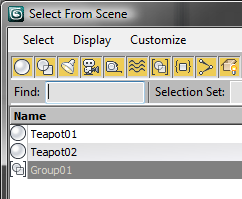 Command entry: Scene Explorer
Command entry: Scene Explorer  Highlight one or more entries.
Highlight one or more entries.  Right-click a highlighted entry.
Right-click a highlighted entry.  Groups
Groups  Group
Group
The Group command combines a selection set of objects or groups into a single group.
Once you group objects, you can treat them as a single object in your scene. You can click any object in the group to select the group object. You can transform the group as a single object, and you can apply modifiers as if it were a single object.
Groups can contain other groups, up to any level.
Group names are similar to object names, except that they’re carried by the group object. In lists like the one in the Selection Floater, group names appear in square brackets. For example: [Group01]. In Scene Explorer and related dialogs, the square brackets enclose the group object icon instead.

A group in Scene Explorer
If a group is selected, its name will appear in “bolded” text in the Name And Color rollout.
All members of a group inherit the visibility of the parent when a visibility controller is assigned to the parent.
Groups are considered whole objects in the Light Exclude/Include dialog, so you can exclude (or include) all objects in a group by selecting the group in the list. If a group is nested within another group, only the "outer" group is available in the list. To exclude only certain objects in a group, open the group before displaying the Exclude/Include dialog.